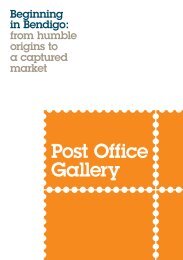Theatrical traditions: stage and screen in Bendigo
This electronic publication accompanies the exhibition Theatrical traditions: stage and screen in Bendigo. Western theatrical traditions came to Bendigo with fortune seekers in the 1850s. Since then, everything from amateur to professional, Shakespeare, opera, live music, eisteddfods, Vaudeville, musicals and comedy have graced the many stages in Bendigo. The beginning of the 20th century heralded the dawn of the motion picture, which by the middle of the century was the most popular form of entertainment. Existing Bendigo theatres quickly adapted and numerous purpose built picture theatres were constructed. Theatrical traditions: stage and screen in Bendigo looked at key moments, venues and people in the evolution of such entertainment in Bendigo.
This electronic publication accompanies the exhibition Theatrical traditions: stage and screen in Bendigo.
Western theatrical traditions came to Bendigo with fortune seekers in the 1850s. Since then, everything from amateur to professional, Shakespeare, opera, live music, eisteddfods, Vaudeville, musicals and comedy have graced the many stages in Bendigo. The beginning of the 20th century heralded the dawn of the motion picture, which by the middle of the century was the most popular form of entertainment. Existing Bendigo theatres quickly adapted and numerous purpose built picture theatres were constructed. Theatrical traditions: stage and screen in Bendigo looked at key moments, venues and people in the evolution of such entertainment in Bendigo.
You also want an ePaper? Increase the reach of your titles
YUMPU automatically turns print PDFs into web optimized ePapers that Google loves.
V<strong>in</strong>cent Kelly<br />
Australia<br />
active 1904 – 1958<br />
Gr<strong>and</strong> open<strong>in</strong>g of the<br />
Lyric Theatre, Char<strong>in</strong>g<br />
Cross<br />
1913<br />
Reproduced from the<br />
<strong>Bendigo</strong> Advertiser<br />
Courtesy Darren<br />
Wright<br />
Despite compet<strong>in</strong>g with several other<br />
picture theatres <strong>in</strong> town, the bus<strong>in</strong>ess<br />
fared well <strong>and</strong> a new site just a few<br />
blocks down Pall Mall at Char<strong>in</strong>g<br />
Cross was procured to build a br<strong>and</strong><br />
new purpose-built theatre for <strong>screen</strong><strong>in</strong>g<br />
films. The first of its k<strong>in</strong>d <strong>in</strong> <strong>Bendigo</strong><br />
the new Lyric Theatre, operated by<br />
Lyric Photo Plays Ltd, opened on<br />
Monday 24 February 1913, with a<br />
<strong>screen</strong><strong>in</strong>g of The Midnight Wedd<strong>in</strong>g. 31<br />
Well-known <strong>Bendigo</strong> family, the<br />
Favaloro’s, operated a concession st<strong>and</strong><br />
on the ground floor, which was also<br />
the box office. 32<br />
Designed by local architects Keogh<br />
<strong>and</strong> Austen, upon open<strong>in</strong>g, the Lyric<br />
was considered the most modern <strong>and</strong><br />
spacious regional theatre <strong>in</strong> the State.<br />
With both Char<strong>in</strong>g Cross <strong>and</strong> Bath<br />
Lane frontage, it seated 1600 people<br />
<strong>and</strong> even though its <strong>in</strong>terior was not<br />
as lavish as other theatres <strong>in</strong> town,<br />
it showed excellent films, ensur<strong>in</strong>g<br />
it quickly became an audience<br />
favourite.<br />
NEW TECHNOLOGIES<br />
The Lyric cont<strong>in</strong>ued to <strong>screen</strong> a steady<br />
stream of silent films with musical<br />
accompaniment until the <strong>in</strong>troduction<br />
of sound on film <strong>in</strong> 1929. Embrac<strong>in</strong>g<br />
the new ‘talkies’, <strong>in</strong> 1930, a state-ofthe-art,<br />
Western Electric sound system<br />
was <strong>in</strong>stalled <strong>and</strong> the first ‘talkie’, Song<br />
of My Heart starr<strong>in</strong>g John McCormick,<br />
<strong>screen</strong>ed at the Lyric.<br />
A couple of months earlier, on Easter<br />
Saturday, the first ‘talkies’ opened at<br />
the Pr<strong>in</strong>cess Theatre with the film The<br />
Desert Song. At this <strong>stage</strong>, sound was not<br />
embedded <strong>in</strong> the film stock, but was<br />
played from a record on an attachment<br />
at the back of the projector. If a piece<br />
of film needed to be removed due to<br />
fault or burn, a piece of blank film had<br />
to be <strong>in</strong>serted <strong>in</strong> order for the sound<br />
<strong>and</strong> vision to rema<strong>in</strong> <strong>in</strong> sync. 33<br />
The <strong>in</strong>troduction of sound on film<br />
triggered a re-evaluation of c<strong>in</strong>ema<br />
design <strong>and</strong> acoustics became a<br />
fundamental consideration. Due to<br />
its dated design for c<strong>in</strong>ema use, the<br />
Pr<strong>in</strong>cess Theatre was closed for remodel<strong>in</strong>g<br />
<strong>in</strong> October 1936. The<br />
architectural firm employed to reth<strong>in</strong>k<br />
its design was Cowper, Murphy<br />
<strong>and</strong> Appleford who chose to replace<br />
the exist<strong>in</strong>g decorative <strong>in</strong>terior with<br />
the clean l<strong>in</strong>es <strong>and</strong> simplified surfaces<br />
of Art Deco. The new-look Pr<strong>in</strong>cess<br />
opened on 4 December 1936 with a<br />
<strong>screen</strong><strong>in</strong>g of Front Page Woman.<br />
Keep<strong>in</strong>g up with the competition,<br />
designed by Melbourne architects<br />
Taylor, Soilleux <strong>and</strong> Overend, <strong>in</strong><br />
1934 extensive alterations also took<br />
place at the Lyric convert<strong>in</strong>g it <strong>in</strong>to a<br />
13

















